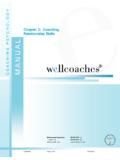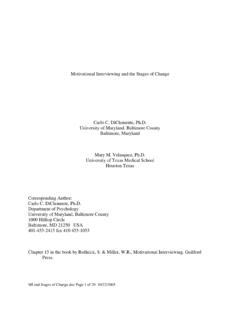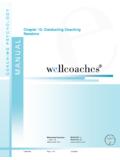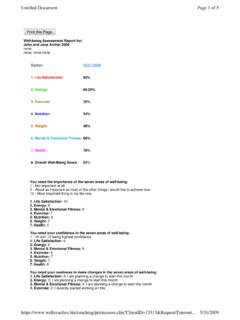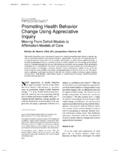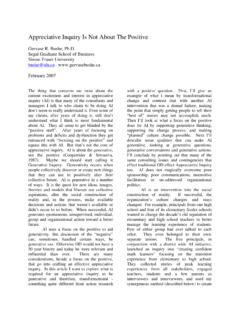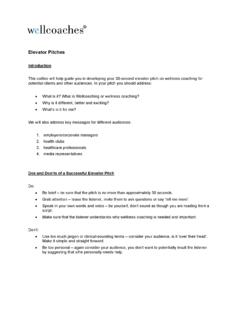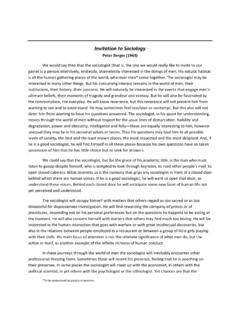Transcription of Berger Kegan key concepts kb - Wellcoaches
1 Jennifer Garvey Berger , 2006 Please do not reproduce without permission 1 Key concepts for Understanding the Work of Robert Kegan Jennifer Garvey Berger General Rationale and Approach In over our heads: Robert Kegan believes that the constantly changing demands of modern life may be developmentally inappropriate for many perhaps even most adults. We should no more blame or punish adults for their inability to meet the challenges of their lives than we would punish an infant for not being able to turn over, or a five-year-old who had not mastered abstract thinking.
2 Instead of blaming adults for simply being unable to meet these demands, Kegan asks that we learn how to support development and have the patience to wait for it to come. He says, The expectations upon something more than mere behavior, the acquisition of specific skills, or the mastery of particular knowledge. They make demands on our minds, on how we know, on the complexity of our consciousness ( Kegan , 1994, p. 5). Constructive-developmental: Kegan is a constructive-developmental psychologist. This is a term which joins together two different schools of thought. Constructivists believe that the world isn t out there to be discovered, but that we create our world by our discovery of it.
3 Humans make meaning of their surroundings, and that meaning is the surrounding; two people who see the same picture differently may actually, in their seeing of it, be creating two different pictures. Developmentalists believe that humans grow and change over time and enter qualitatively different phases as they grow. Cognitive, moral, and social development, however, unlike physical development, isn t a matter of simply waiting for nature to take its course. Development can be helped or hindered (and in some severe cases arrested) by the individual s life experiences. Constructive-developmentalists believe that the systems by which people make meaning grow and change over time.
4 Information: In-form-ation is new knowledge that you add to the current form of your mind. New skills or knowledge may be important for keeping up with the newest technology or the latest cutting-edge work in your profession. Information, while helpful, is generally by itself not a sufficient kind of growth for adults, however. All adults, as growing and changing people, need more than simply information; they need transformation. Transformation: Transformation is more than simply adding information into the container (your mind, for example) that already exists. Transformation is about changing the very form of the container making it larger, more complex, more able to deal with multiple demands and uncertainty.
5 Transformation occurs, according to Kegan , when you are newly able to step back and reflect on something and make decisions about it. There are many ways that transformation can happen; one of them is the movement of things from Subject to Object (see below). Kegan (1994) says transformative learning happens when someone Jennifer Garvey Berger , 2006 Please do not reproduce without permission 2 changes, not just the way he behaves, not just the way he feels, but the way he knows not just what he knows but the way he knows (p. 17). Subject: Things that are Subject are by definition experienced as unquestioned, simply a part of the self.
6 They can include many different things a relational issue, a personality trait, an assumption about the way the world works, behaviors, emotions, etc. Things that are Subject to you can t be seen because they are a part of you. Because they can t be seen, they are taken for granted, taken for true or not even taken at all. You generally can t name things that are Subject, and you certainly can t reflect upon them that would require the ability to stand back and take a look at them. You don t have something that s Subject; something that s Subject has you. Kegan (1994) describes Subject as those elements of our knowing or organizing that we are identified with, tied to, fused with or embedded in (p.)
7 32). For example, I once thought that all people learn things in basically the same way the way I learned them. When students came to me with difficulty about an assignment or test, I thought the problem was theirs; I was being so clear and they were still not learning. I struggled and struggled to help them learn, but to no avail. My own teaching and learning styles were Subject to me. I didn t know different styles existed (because I figured everyone taught and learned like me), so I was powerless to change my style to meet the needs of diverse learners. Object: Object is the opposite of Subject.
8 Again, something that is Object can be a relational issue, personality trait, or a belief about the world. While things that are Subject have you, you have things that are Object. Things that are Object in our lives are those elements of our knowing or organizing that we can reflect on, handle, look at, be responsible for, relate to each other, take control of, internalize, assimilate, or otherwise operate upon ( Kegan , 1994, p. 32). While every person necessarily has many parts of their world which are Subject (if you gave much conscious thought to your assumptions about gravity, you might not have time to go to sleep at night!)
9 , one part of development is about moving more and more things in your perception of your self from Subject to Object. The more in your life you take as Object, the more complex your world view because you can see and act upon more things. In the example above, as I struggled to help my students learn, I found out about teaching and learning styles especially as they relate to personality type. For the first time I could examine something I hadn t even known existed before my own teaching and learning styles and I could take action to help my students be more successful. What was once unknown and unnamed Subject became within my ability to reflect on as Object.
10 The most profound example of a move from Subject to Object is when the entire meaning-making system moves from that which unquestioningly runs the person involved to that which the person can actively control and take charge of. This shift of entire systems from Subject to Object is what gives form to the five Orders of Mind in Kegan s theory. Jennifer Garvey Berger , 2006 Please do not reproduce without permission 3 Orders of Mind Orders of mind: These are Kegan s ideas about the qualitatively different ways of constructing reality. This is a constructive-developmental theory because it is concerned both with the construction of reality, and with the development of that construction to more complex levels over time.
